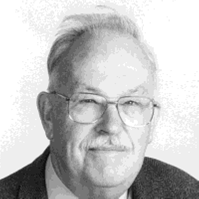Aubrey Dennis Jenkins 6 September 1927 – 25 April 2021

Aubrey was born in London and educated at Dartford Grammar School and the Sir John Cass Technical Institute of the University of London (Now London Metropolitan University). He gained his BSc and PhD at King’s College, London, his PhD work being on the decomposition of organic peroxides.
He began his industrial career in 1950 at the Fundamental Research Laboratory of Courtaulds Ltd in Maidenhead, working with CH Bamford. Courtaulds was then one of the world’s largest producers of synthetic fibres, using materials based on chemical treatments of cellulose as replacements for cotton. The company was actively seeking synthetic substitutes for silk and became a centre for research in free-radical polymerisations of vinyl monomers, especially acrylonitrile. Aubrey’s research focused on the mechanisms and kinetics of these reactions, and he made significant contributions to the understanding of their initiation, retardation, and inhibition, particularly inhibition by transition metal salts. The book “The Kinetics of Vinyl Polymerization by Radical Mechanisms” by Bamford, Barb, Jenkins, and Onyon, published in 1958, became a key text for anyone working in the field. The Courtaulds group were the first to propose the idea of “trapped” radicals in acrylonitrile polymerisations and to record the paramagnetic resonance spectrum of a polymeric radical.
Free-radical polymerisations often use monomer mixtures to produce copolymers. Although superficially simple, copolymerisations are actually very complex, the distribution of repeat units in the polymer depending on the relative reactivities of the two monomers and the two possible polymerising radicals. Aubrey worked extensively on the understanding of radical and monomer reactivity, developing an empirical prediction method which became known as the “patterns scheme”. This was a topic which interested him throughout his career and into retirement; his first “patterns” paper was published in 1959 and the last in 2000.
Aubrey left Courtaulds in 1960 and moved to the Fundamental Research Laboratory of the Gillette company, where he worked on the chemistry of hair treatments, spending three years at their laboratories in Reading and one at their Harris Research Laboratories in Washington.
He moved to Sussex in 1964, as Senior Lecturer in Chemistry, one of the early appointments in the newly created School. After promotion to Reader, he was appointed to a Chair in 1971 and served as Dean for most of the 1970s. In Sussex he continued research into the kinetics of radical polymerisation and also developed interests in organometallic compounds as initiators for acrylonitrile polymerisation, controlled structure polymers via enolate-initiated reactions, preparation of polymers with liquid crystal character and synthesis of polymers bearing fluorescent groups. A good deal of this work was done in collaboration with David Walton in Sussex, and he also worked with Mitch Winnick and Jim Guillet in Canada.
The first major post-war international conferences on polymers to be held behind the Iron Curtain took place in Prague in 1957 and 1964. Many UK polymer scientists attended and discovered a beautiful city and an active research community in the Czech Institute for Macromolecular Chemistry. Aubrey developed a particular affinity for both city and Institute and visited the Czech Institute as often as he could. He eventually split a year’s sabbatical leave between Visiting Professorships in Prague and at the University of Massachusetts. He remained closely associated with the Prague Institute and was awarded the Heyrovsky Gold Medal for Chemistry of the Czech Academy of Sciences in 1990. His second wife, Jitka was a staff member at the Prague Institute. He also had collaborations in South America and was made an Honorary Fellow of the Organic Chemistry Society of Argentina in 1993.
Aubrey was prime mover in the setting up of the Sussex undergraduate degree programme in Polymer Science which had a number of successful years before changing fashions led to it becoming Chemistry with Polymer Science, and eventually fading away.
In 1976 Aubrey became involved in the International Union of Pure and Applied Chemistry (IUPAC) and developed a deep involvement in macromolecular nomenclature. He served as chairman of the Committee on Macromolecular Nomenclature from 1977 to 1985 and was for eight years secretary of the Macromolecular Division. He was a member of the British Committee for IUPAC, the UNESCO European Expert Committee on Polymer Science, Industry, and Environment, and the British Library Scientific Committee. He was a fellow of the Royal Society of Chemistry and a member of the Society of Chemical Industry. He served as secretary of the UK High Polymer Research Group from 1991 to 2002. His administrative experience gave him stubbornly defended views about the positions of commas and semicolons that were put to good use in setting University examination papers.
Outside his academic life Aubrey was a board member for the Brighton District Health Authority, and the West Sussex Institute of Higher Education (now the University of Chichester). His hobbies included photography and classical music. He had a particular passion for the music of Richard Strauss and rarely missed an opportunity to see a production of a Strauss opera. Even in later life, when he was confined to a wheelchair, he was a regular visitor to both Glyndebourne and Covent Garden whenever Strauss was being performed.
Aubrey is survived by his second wife, Jitka, two sons from his first marriage, nine grandchildren and four great-grandchildren.
Norman Billingham